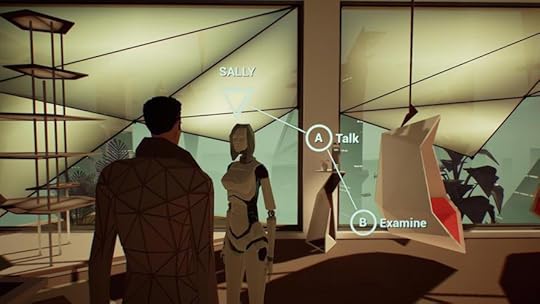Kill Screen Magazine's Blog, page 86
July 25, 2016
TextureWriter might be the best interactive fiction tool for beginners
Header image by Paul Downey
An announcement on Twitter last week revealed a new piece of software called TextureWriter, which supposedly makes creating interactive fiction easier than ever. Joining other IF (interactive fiction) tools like Twine and Inform, TextureWriter offers a different and more intuitive way to navigate through a story. Like Twine and Inform, TextureWriter doesn’t require any coding knowledge to create a story. But it also incorporates a much more user-friendly interface than the others, using a simple click and drag button prompt called an “interaction word.”
Interactive fiction simulates environments where players can choose different paths for characters, allowing them to shape the story to get different outcomes. Growing out of the Choose Your Own Adventure novel, one of its earliest examples in games was the text-based Zork (1980). The genre now takes many forms in videogames, but usually maintains the text-only approach. Most tools for novice interactive fiction writers are browser-based, and can even accommodate sound and graphical elements.
Usually, to progress or make decisions in the story, these programs highlight and hyperlink words that bring users to a new browser page. But in TextureWriter, you drag the interaction button over the highlighted word of your choice so the rest of the story materializes underneath it on the same page. This changes the user experience, making it more active and intuitive by replacing clicking with dragging and dropping. Being able to use your finger to drag and drop “action words” onto the desired phrase will be useful in terms of accessibility for the player, especially since it allows them to read stories on touchscreen devices as well as the usual web browser.
This changes the user experience, making it more active and intuitive
If you’re interested in creating your own interactive fiction, TextureWriter appears to be one of the most novice-friendly tools. You can create an account to save your stories, but it isn’t necessary since your work is saved locally. As you type within the editor, you can use the tabs off to the side of the work space to preview what you have written, change the settings, bold and italicize words, or even publish your story. When you wish to add an interactive word to something you’ve written, just click and drag it onto the desired option. A new prompt shows up, giving you the option to add more text (before or after the paragraph), turn to other pages, or add and remove flags (which allow you to specify a new behavior within the editor).
It will be interesting to see how the IF writer community will use these new capabilities. While there isn’t a lot of examples on the TextureWriter’s website yet, they provide a great 10 minute tutorial for newcomers on how to use the software.
Visit TextureWriters website here.
The post TextureWriter might be the best interactive fiction tool for beginners appeared first on Kill Screen.
July 23, 2016
Weekend Reading: The Republican National Comic Convention
While we at Kill Screen love to bring you our own crop of game critique and perspective, there are many articles on games, technology, and art around the web that are worth reading and sharing. So that is why this weekly reading list exists, bringing light to some of the articles that have captured our attention, and should also capture yours.
///
Around 10 years ago, a DJ and Oxford grad stumbled upon a thousand hours of recordings in the famous Pitt Rivers Museum—sounds from the Bayaka, a community in the rainforests of the Central African Republic. Because of how precariously those recordings were stored, this individual set off to document music that had existed for centuries but was at the risk of being lost for good, meeting up with the researcher who had initially made the recordings, and that’s just the tip of the story explored by Motherboard’s Emiko Jozuka.
I’m With The Banned, Laurie Penny, Welcome to the Scream Room/Medium
There have been a few interviews and profiles on Milo Yiannopoulos—the Breitbart reporter, Mac Tonight lookalike, and personality who requires a fleet of interns to complain about other web pages—recently made notable again for being banned from Twitter. Many of those profiles get hooked on his personable charm and attempts to humanize one of the internet’s most efficient jackasses, but Laurie Penny waves that notion, pre-disillusioned with him, instead joining him on to the carnival ride of the Republican National Convention and praying to get off.
Image by Lia Kantrowitz, via Vice
How Pokémon Would Probably Fuck: An Investigation, Drew Millard, Vice
Pokémon. We love them. We hate them. We catch them all. But more importantly, how do they knock boots? Drew Millard wants to know, and he pretty much asks everyone imaginable to find out.
White Plight?, Hua Hsu, The New Yorker
There seems to be few things as contentious as when white Americans consider themselves as “outsiders,” but as Hua Hsu elaborates these notions did not develop when Barack Obama took office.
///
Header image: Drew Angerer / Getty Images, via Medium
The post Weekend Reading: The Republican National Comic Convention appeared first on Kill Screen.
July 22, 2016
State of Mind combines transhumanism and a low-poly look
It seems like every other week we’re hearing about a new game that wants to use robots, spaceships and/or the concept of a digital future to make a larger point about the world we live in. Many of these games work well; others, not so much. The genre oversaturation ensures that any new game checking off one or many of these boxes needs some way to stand out from the rest of the crowd.
And, lo, a pretty, low-poly contender just pushed its way to the front. Upcoming adventure game State of Mind explores transhumanism by creating two separate worlds: reality, and a virtual reality project created using a template of the main character Richard Nolan’s mind, but without his knowledge or consent. The game wants to explore themes of “separation, disjuncture and reunification” through dystopian fiction and the idea of a world “on the brink of a post-material existence.”
Though Richard is the main character, State of Mind will have multiple playable characters within its two worlds. The art style is stunning and appropriate for the topic, blocky but not boring, and early screenshots show robot-like characters as well as a bustling city. More interestingly, they also contain allusions to the “United States of the West,” perhaps another aspect of the systems that are experimenting with mind uploads. Like the rest of the screenshots, it’s reminiscent of good, classic sci-fi, the kind that used lots of blue light and unnecessary capital letters and wasn’t afraid to get a little camp.
Daedalic Entertainment, a German developer, has already confirmed that State of Mind will be out on both PC and consoles, though an exact date hasn’t been specified yet (thought 2017 has been stated). Hopefully once it arrives, we’ll find that the execution is as sharp as the rest of it.
Check out State of Mind on Steam .
The post State of Mind combines transhumanism and a low-poly look appeared first on Kill Screen.
Totally Accurate Battle Simulator will deliver the most (un)accurate warfare yet
From the medieval battlefields of Mount & Blade to the near-future combat of Call of Duty, we’ve seen war in videogames portrayed in myriad forms: the tactical control of Total War, the civilian perspective in This War of Mine (2014), the ground-level chaos of Battlefield. But Totally Accurate Battle Simulator promises to deliver the most accurate digital warfare yet. Surely that name doesn’t raise any alarms.
[image error]
Oh, so, perhaps it’s not the most accurate depiction of the battlefield, but it does look like the most vibrant and goofy take on chaotic combat this side of Gang Beasts. Developer Landfall Games is currently putting the final touches on their madcap truck-based platformer Clustertruck, and the physics silliness of that game seems to have brought fully-formed into their next project. Totally Accurate Battle Simulator is only at the pre-alpha stage, featuring some missions and a sandbox to test, but it’s already a visual spectacle.
cannonballs barrel through charging soldiers
Placing a wall of shield barriers with a phalanx of spears behind them, with cannons and ballistas raining projectiles from the back lines. A horde of peasants and club-wielding barbarians facing a rushing line of chariots. The physics-based combat means cannonballs barrel through charging soldiers, unleashing ballista bolts fling their launchers around wildly, and explosions send colorful bodies flipping through the air.
The pre-alpha has the feel of a puzzle game as limited funds challenge you to form the most effective defense against the enemy army, but Totally Accurate Battle Simulator is still early in development, and the structure and features will likely be extensively expanded upon throughout development.
Totally Accurate Battle Simulator will be entering alpha later this year. You can follow the game’s progress on its website.
The post Totally Accurate Battle Simulator will deliver the most (un)accurate warfare yet appeared first on Kill Screen.
Dear Esther is being turned into a live musical performance
Fans of The Chinese Room will want to keep a slot open in their diaries. The Barbican has teamed up with the studio to put together a live performance of their game Dear Esther (2012) on October 14th. The performance will coincide with the Xbox One and PlayStation 4 re-releases of the game.
Dear Esther was part of the birth of a new genre of videogames, the walking simulator/exploration game/look-em-up (delete as applicable.) It is, it’s fair to say, a landmark in games, and this chance to experience it live isn’t one to be missed.
“A deserted landscape, memories of a fatal crash”
But, how do you have a live performance of a game? The audience will be in attendance for a live playthrough of the game by developer Dan Pinchbeck, accompanied by live narration from Nigel Carrington, and a live musical performance of the score penned by Chinese Room co-founder Jessica Curry.
The Barbican’s blurb for the event opens dramatically: “A deserted landscape, memories of a fatal crash, a book written by a dying explorer—explore an island shrouded in mystery in this live performance of The Chinese Room’s immersive video game Dear Esther.” If you’re familiar with The Chinese Room but not Dear Esther that may be due to having played their tale of a very British apocalypse in last year’s Everybody’s Gone To Rapture. If that is the case, then you should consider checking out Dear Esther, for it is the blueprint that Everybody’s Gone to the Rapture was developed from.
Lana Polansky, writing for Kill Screen, describes the game as “poetic,” noting “its melancholy beauty is almost Byronic.” There’s almost an irony to experiencing one of Chinese Room’s titles, often they’re shrines to loneliness and perfectly capture a sense of stillness and isolation that’s often chilling.
If you haven’t played the game for the first time yet, this could be one of the best ways to experience the two hour game, with tickets priced at £22.50 and membership discounts available.
The post Dear Esther is being turned into a live musical performance appeared first on Kill Screen.
American politics are imploding so you better back Trump Cards
The Republican National Convention, in the midst of the chaos that has been this election, has officially nominated Donald Trump as their candidate for President of the United States of America. This isn’t a Simpsons joke, though it was, once. It’s the world we live in, somehow. While you contemplate that, biting your nails and staring across the room at the drawer you’re pretty sure your passport is in, consider this: there may still be a way to make this election fun and games.
Not the actual election, of course, because this election is a nightmare, we live in a nightmare universe, oh God, how did this happen—okay. A Kickstarter wants to make playing cards out of Donald Trump’s bizarre campaign for President, and you need to support them to justify this whole mess.
The State of Affairs:
Barack Obama. King. Elegantly bow-tied.
Bernie Sanders. Jack. Twittering bird perched serenely on his outstretched hand, perhaps illustrating the size of his chance to win the presidency (1x1pixels.)
Ted Cruz. King. Except not after a couple nights ago. Now, more appropriately, a small pile of ash formed into the words “vote your conscience.”
Nate Silver. King. Brandishing a burrito.
Hillary Clinton. +1: the Woman Card. Keep in your wallet to destroy the deck as well as the patriarchy.
The Drumpf. Like Senator Cruz, soon to be set on fire.
These noble stalwart inspirational various politicians leaders reality show contestants people are illustrated by the duo behind Kings of India, and bring a measured elegance not found anywhere on cable news in the past six months. Their sacrifice is admirable: other characters will include Chris Christie, Megyn Kelly, Jeb Bush, and Donald Trump three times.
we live in a nightmare universe
To bring a bit of hope to the table, Trump Cards (aptly named) are going to include a betting version where the loser donates $10 to a charity of the winner’s choice. The ethical dilemma of making a very real threat to our nation into a card game is soothed somewhat: they’re well aware of which issues “Trump’s rise puts in jeopardy,” and hope to work with the ACLU, the Southern Poverty Law Center, and the International Rescue Committee. They’re doing their part to make something good out of something very, very bad.
We’re still in Hell, though. Just want to make that clear.
Back Trump Cards on Kickstarter before the world ends.
The post American politics are imploding so you better back Trump Cards appeared first on Kill Screen.
Sunless Sea director’s next game is all about crafting new, cultish words
In what he is entitling “devlog zero,” Alexis Kennedy—former CEO of interactive fiction developer Failbetter Games and creative director of the astounding Sunless Sea (2015)—has announced his newest project: Cultist Simulator.
Kennedy describes the project as follows: “Cultist Simulator is AdVenture Capitalist meets single-player Fallen London meets Doodle God, set in the NOON world that I’m going to build my next game in.” It’s a crafting game for English language nerds, allowing you the ability to combine words by their meaning into new words that take elements of the old and incorporate them into a wholly new product. At its core, it shares the base structures of all crafting systems: you are making things out of other things.
its own form of narrative crafting
Combining a clicker game with a large-scale work of interactive fiction (not to mention the other mentions that Kennedy drops in their post) is a determinedly original premise, its own form of narrative crafting. That you can then take “a Family Connection and a Wistful Dream together and create a Horrible Tragedy” has all the promise of a late night with a good Russian drama—it was Tolstoy who opined “All happy families are alike; each unhappy family is unhappy in its own way.’
Cultist Simulator is still in early alpha, and if the earlier description tickles your fancy—or indeed if your interest is peaked by the world’s tiniest screenshot—you can find out more information from Kennedy’s mailing list.
///
Header image via Wikimedia
The post Sunless Sea director’s next game is all about crafting new, cultish words appeared first on Kill Screen.
The apocalyptic fandom of No Man’s Sky
According to American evangelist Harold Camping, the Rapture was supposed to have occurred on May 21, 2011—the date was moved back five months to October when nothing happened. Apocalyptic preacher Ronald Weinland predicted that the world would end on September 30, 2008. This date was also revised to May 27, 2012, and then May 19, 2013. In a similar vein, No Man’s Sky was supposed to have been released on June 21, 2016—that particular rapture was pushed back to August 9.
Though the fact of fandom is hardly unique to No Man’s Sky, the degree of devotion the game’s fans show is noteworthy for its intensity. The occasional visit to the No Man’s Sky’s subreddit, for example, reveals a particularly intense depth of feeling: upon learning that the game had gone gold one fan suggested that the master disk should be placed in the Smithsonian. Earlier, another fan photoshopped the lead developer Sean Murray’s face onto a typical image of Jesus. Months ago, one fan claimed that the game will “make my dreams come true!” But all of this is just naked, good-hearted enthusiasm that exists for good reason—it’s difficult to think of, Spore (2008) aside, a game so ambitious and that has received such support in the wider cultural landscape. Murray was invited onto the Late Show with Stephen Colbert, after all. And there was that New Yorker profile.
“OUT OF PATIENCE, AND FAITH”
But the darker side of this energy is the well of possessive rancor felt by some members of the community. When a Kotaku scoop announced the game was being delayed, one fan was so desperate to prove Kotaku wrong that they phoned over thirty GameStops for shipping information to rebut the claims, while others lamented that the vacation time they had booked to allow for a truly immersive first taste would likely go to waste. Murray noted that he had received death threats in reaction to the delay’s announcement. Present also in the community is the converse of enthusiasm: exhaustion, faithlessness, and fear. “I’m out of patience, and faith,” says one anonymous commentator. Another describes themselves as simply exhausted. A third posted a thread with the title “I’m getting… scared,” only to receive reassurances of the game’s expected quality.
Taken together, both extremes point to a depth of feeling comparable with—even identical to—religious fervor. The New Yorker piece even hinted at this element in its title, “World without End” being a phrase from the Gloria Patri, a part of the Catholic Mass: “As it was in the beginning, is now and ever shall be, world without end. Amen.” But the specific kind of religious fervor the buzz surrounding the game resembles that of an apocalyptic faith.
Image source: /r/NoMansSky
Thanks to disaster movies, the Book of Revelations, and Christian Evangelicalism, apocalypticism connotes a dramatic, permanent, and often metaphysical upheaval. The Day after Tomorrow (2004) is, in a sense, apocalyptic; so too is the more conventional Left Behind series of novels. In many ways, however, the emphasis on physical destruction is overstating the case. Apocalypticism merely refers to the passing away of a “darker” age, and a progression into a more just one. It doesn’t necessitate the absolute, metaphysical destruction of the world and its divine replacement: the Third Jewish Revolt (132-136) had apocalyptic dimensions in that its leader, Simon bar Kokhba, was named as messiah on the basis that he would lead his people to freedom from Roman rule. Put another way, he would lead Judea from a dark age of pagan rule to a more godly one. This concern with the materiality of apocalypse—the way in which the unveiling is concerned with politics or the social fabric—has dropped out of the word’s connotations.
But it was present in the earliest forms of, at least, Christianity. The author of the Gospel of Luke, for example, uses the word “saviour” (original Ancient Greek: sōtēr) to describe Jesus. But this word bears a distinct political meaning in its original language: while it was a title given to Greek gods, it was equally a title given to political and military leaders. Ptolemy and Antiochus, generals under Alexander the Great, were given the epithet because they brought some measure of stability as they divided Alexander’s empire among themselves. The first Emperor of Rome, Augustus, was similarly named saviour, among his many, many other titles. In the same vein, religious movements we are tacitly more familiar with also liked to emphasize the material world—St. Paul instituted one of the core tenets of the early Jesus movement (the name given to what would become Christianity in the first century CE) by articulating the promise of a bodily resurrection. Ideas of salvation and apocalypse can then have a worldly element: they are political and social; physical, not merely metaphysical; literally mundane, not otherworldly.
NO MAN’S SKY BEARS THE PROMISE OF A KIND OF INFINITUDE NOT USUALLY FOUND ON THIS EARTH
The experience of the long wait for No Man’s Sky resembles that of the faithful for this kind of material apocalypse—for the moment when the old order passes away, and a new world is given in its stead. Indeed, No Man’s Sky has a superfluity of worlds available to the player, and the symbolic weight of its alleged 18 quintillion planets bears the promise of a kind of infinitude not usually found on this Earth. Its combinatorial logic offers endless variety of sounds and sights; the sheer depth of experience available is more than one lifetime can process. But the promise it offers is a material one: this is no New Jerusalem, just a complete renovation of one’s leisure time—that is, an alleged renovation, of course. The only actual proof we have lies in what we have seen in livestreams, articles, and so on. But this lack of concrete, experiential proof is almost irrelevant. To quote St. Paul, “faith is the substance of things hoped for; the evidence of things not seen.”
Nevertheless, the wellsprings of apocalypticism remain constant. The need for the drastic turnaround is rarely going to be absent, whether you’re a second-century Judean struggling under the Roman yoke, or a 21st-century modern dissatisfied with the restrictive conventions of current videogames. The promise of an apocalyptic belief is that the current situation will be replaced by its utter opposite. This age of darkness will be replaced with an age of light; you are a slave, but you will be free. “Blessed are they that mourn: for they shall be comforted,” says Christ in the Sermon on the Mount. In this instance, the moral dimension of the framework—where the believer, at least, hopes that they are on the right side of things—is not present. But the sense of absence and the need for fulfillment is present nevertheless.
The question of what kind of absence the game can fill is impossibly broad—the human condition is one of longing. Any attempt to describe a specific void would be undone by particulars. But in a way, this caveat doesn’t matter: if the promise of No Man’s Sky is the infinite, unrepetitive experience of the universe, surely it’s up to the task of slaking man’s infinite desire? One fan marked July 18 by pointing out that there were just “21 days until the universe is ours.” And the universe is a very large place: surely you can find in the profound depths of an illimitable sandbox the cure for what ails you.
But what happens if this apocalypse fails to meet expectations? St. Paul had to deal with his own brand of disenchantment: the Early Jesus Movement was convinced that they were living in the last days, and that any moment Christ would return to usher in the apocalypse. When older members of the church began dying off before this promise could be fulfilled, St. Paul was able to massage (or patch?) the doctrine. His vital change instructed that those who had “fallen asleep” would be raised again at the end, with Christ’s own resurrection serving as a model. The apocalyptic faith was still present, even as its specific contours had changed. The lesson here is that faith evolves—Christianity in the first century does not perfectly resemble Christianity in the ninth century. So, too, will go the expectations for No Man’s Sky, where the promise of patches and digitally-delivered updates can serve to mollify the faithful into believing that the infinite is not upon them yet, but after a few years and enough developer support, it will be. The game’s possible failures, when married to the promise of improvement, will become the substance of things hoped for.
FAITH EVOLVES – SO TOO WILL EXPECTATIONS FOR NO MAN’S SKY
Now for the regular caveats: this apocalyptic dimension to fandom is not limited to No Man’s Sky and its devotees. Rather, it’s a recurrent enthusiasm that follows any kind of novelty like a shadow. But the community for No Man’s Sky has managed to provide enough examples of this kind of faith in the game to make it emblematic—again, what other game received time on late-night television? What other game offers a sandbox larger than our galaxy, for only eight gigabytes of space on your hard drive?
The end of the world may come like a thief in the night, but the videogame industry needs a hard deadline. So: the next rapture—when the faithful will be taken from this world and into a better one—is set for August 9. For the rest of us, life will carry on as usual.
The post The apocalyptic fandom of No Man’s Sky appeared first on Kill Screen.
July 21, 2016
The ’70s disco aesthetic gets some videogame love
Laser Disco Defenders is defined by ‘70s Star Wars knock-offs—the kookier, the better. We’re talking films like Star Crash (1979) and Buck Rogers (1979); movies that might as well have had their robot characters made out of tinfoil. Only, for the purposes of describing the game, imagine those movies set to a fly disco soundtrack, daddio.
Creator Alexander Birke had always been interested in creating a videogame with a b-movie feel, and disco felt like a natural pairing. After all, Star Wars’s success in the ‘70s catapulted science fiction to the forefront, and even disco got in on it. Hence we have Laser Disco Defenders. The mish-mash aesthetic is something Birke stuck to diligently while he was making the game—he even has a fascinating document full of inspirations that guided him along.
turntable turrets that shoot colorful laser beams
This is why the main challenge is to dodge procedurally-generated obstacles, like turntable turrets that shoot colorful laser beams. Each character can shoot laser beams, too, but you’ll want to plan that carefully. Laser Disco Defenders is a self-inflicted bullet hell, meaning that “friendly” bullets will bounce back and hit players.
The game’s lead character, Mr. Baker, is an homage to disco’s deep roots in African American history, “with the TV program Soul Train being the center pivot for the genre,” Birke said—though Mr. Baker is actually named after German disco group Boney M.’s Ma Baker. “Originally [the lead] was Tommy, who is named after Tommy Seebach, a Danish disco star where I’m from,” Birke added. “But as we got the characters more developed, it was clear that Mr. Baker had to be the lead given the inspiration of the game and how groovy he turned out to be.”
There are four playable characters total—Mr. Baker, Donna, Tommy, and Liz—and each is equally funky; something that is not only entrenched in the aesthetic, but the game’s action, too. Players can customize their characters with a selection of groovy, space-age accessories that each have an affect on how the characters play. In its current iteration, Laser Disco Defenders offers 108 different outfit combinations—ranging from a silver space suit and casual platform shoes, to moon boots and a gold medallion.
“I’m hoping that the players will not only pick a character and outfit based on how it plays, but also on the look they like most,” Birke said. “Fashion was a big part of the disco fever, so I also wanted that to be reflected in the game.”
Laser Disco Defenders will be out for PlayStation Vita on July 26. It’ll also be out on PlayStation 4 later this year, and will be cross-buy on both platforms.

The post The ’70s disco aesthetic gets some videogame love appeared first on Kill Screen.
Get ready to build a relationship with an emotional AI this September
Last time we heard about Event[0] was back in February 2015 with a 20-minute playable demo. That was a while ago, so it’s understandable that we now have a new trailer and a confirmed September 2016 release date (plus, it’s being backed by Indie Fund now). Léonard Carpentier, the producer of Event[0] said that the team has used that old demo to help flesh out the responses from Kaizen, the AI operator on the game’s spacecraft, so the experience can be as convincing as possible.
To recap, in Event[0], you play the sole crew member of an AI-operated spacecraft named Nautilus. Kaizen is constantly juggling emotions ranging from loneliness to jealousy to euphoria, which you will have to learn to manage. She is your only friend in space and, more importantly, the only way back home to Earth.
The majority of the game is spent communicating with Kaizen through a computer terminal. It’s reminiscent of classic text-based games like Zork I: The Great Underground Empire (1980) and Lost Pig (2007), with the extra challenge of managing that shaky relationship. Beyond typing, you’ll be able to explore 3D environments to search for information and solve hacking puzzles, which are essential steps to making it back home. You’ll even be able to take a peek outside to remind yourself of the vastness of space, which is of course inescapable without the help of Kaizen—you know, just in case you want to stare death in the face, I guess.
It should be no surprise that Event[0] is inspired by previous retro-future universes such as 2001: A Space Odyssey (1968), Solaris (1972), and Brave New World (1932). Pretty typical for any popular sci-fi, and these influences in particular seem to be getting more popular as references, likely due to the fact that these fictions are becoming more and more blurred with our current reality. Elizabeth Alsop of The Atlantic made the claim last year that the “future” we love to watch is already here, especially when considering a film like Ex Machina (2015).
Friend or foe?
It’s easy to believe that a robot could toy with your emotions today at the same level (if not higher) as a human. We don’t have self-driving spacecrafts like Nautilus, but we do have self-driving cars already being developed. Stephen Hawking has also made the claim that AI has the potential to wipe out humanity (not that we haven’t thought this a million times before) if it were able to further its own purpose. This is a theme that Event[0] won’t shy from, begging the question of what will happen as we continue to interact with Kaizen. Friend or foe? We’ll have to wait until September to find out.
You can find out more about Event[0] over on its website. It’ll be available for Windows and Mac this September.
The post Get ready to build a relationship with an emotional AI this September appeared first on Kill Screen.
Kill Screen Magazine's Blog
- Kill Screen Magazine's profile
- 4 followers

















![Event[0]](https://i.gr-assets.com/images/S/compressed.photo.goodreads.com/hostedimages/1469205547i/19792655._SX540_.jpg)
![Event[0]](https://i.gr-assets.com/images/S/compressed.photo.goodreads.com/hostedimages/1469205547i/19792656._SX540_.jpg)
![Event[0]](https://i.gr-assets.com/images/S/compressed.photo.goodreads.com/hostedimages/1469205547i/19792657._SX540_.jpg)

